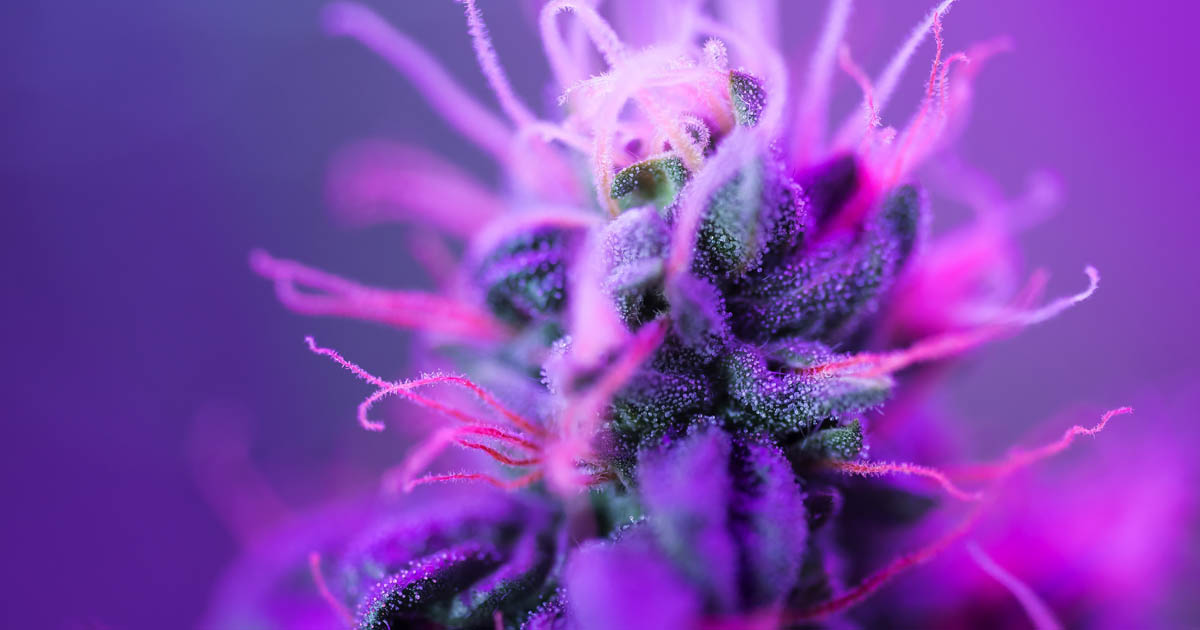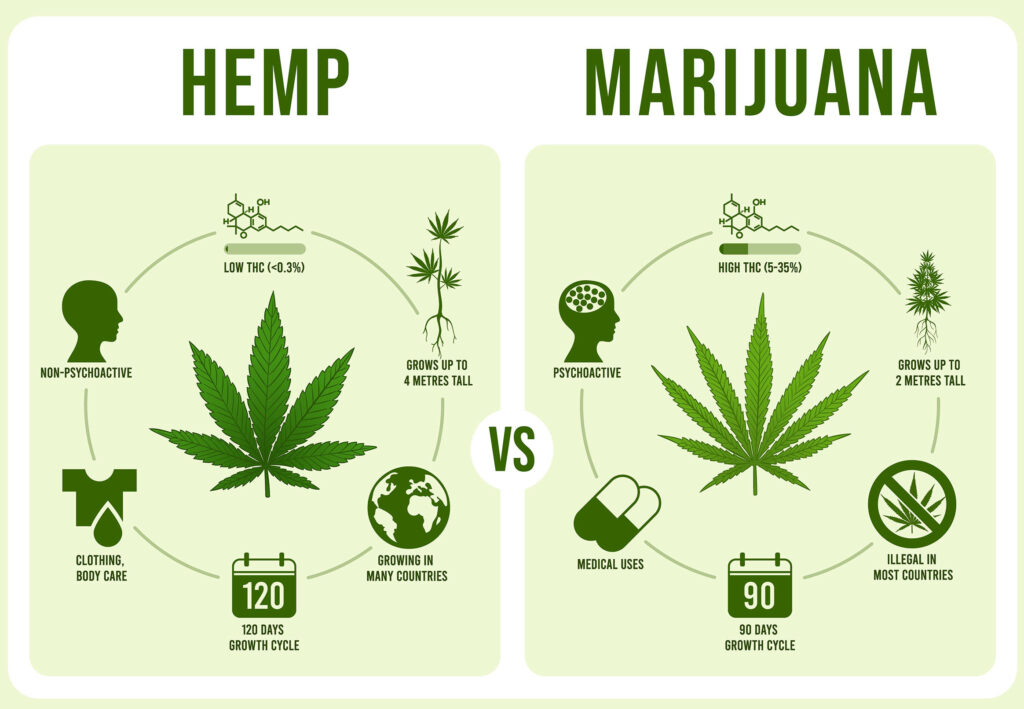70% Off Sitewide! Use code: TAKE70

Hemp Is Not Hashish! — Explaining The Hemp vs. Marijuana Distinction
Hemp may look and smell like marijuana, but that doesn’t mean it shares pot’s psychedelic effects. Indeed, hemp and marijuana are so distinct that they may as well be from different plants.
However, since hemp is in the cannabis family, it’s easy for customers (or ill-informed journalists) to associate high-inducing effects with hemp flowers. People who expect to get “baked” by smoking sticky hemp nugs are always disappointed.
Hemp vs. Marijuana — The Core Factors That Separate These Cannabis Flowers
Thankfully, as CBD takes the world by storm, more people are learning about the significant differences between hemp and marijuana. Although these plants share a similar history, they are distinct for many good reasons.

THC Is The Key! — The Centrality Of Cannabinoid Concentrations
There are a few ways to differentiate hemp and marijuana, but cannabinoid percentages will always be the crucial distinction. Indeed, you can’t talk about hemp vs. marijuana without mentioning delta-9 THC.
For decades, scientists have known that delta-9 is most responsible for weed’s stereotypical “high” effects. Yes, this is the cannabinoid that gives users a rush of euphoria, a bellyful of giggles, and a severe case of the munchies.
In nature, hemp will always have less delta-9 THC than marijuana. Therefore, hemp flowers have a minimal risk of psychoactive side effects, especially compared with marijuana hybrids.
Instead of THC, hemp nugs contain abundant traces of the non-psychoactive cannabinoid CBD. Marijuana could also have CBD, but most strains only have < 1 percent.
As a side note: Hemp flowers could contain traces of rare THC-related cannabinoids. For instance, many hemp breeders are growing strains with significant levels of the psychoactive delta-8 THC.
If you’re wondering how delta-8 differs from delta-9 THC, we’d recommend checking out this previous blog post.
Since Hemp Joints Have No Delta-9, They Aren’t A Crime…Right?
Hemp’s low THC percentage is the primary reason lawmakers aren’t so harsh on this cannabis variant. Indeed, since 2014, it has been legal in the US to grow and study hemp at registered universities. As of 2018, anyone in the USA could buy, sell, and use products that meet the US Farm Bill’s latest requirements.
Per the US Federal Government, hemp flowers and derivatives can’t have more than 0.3 percent delta-9 THC. As long as a hemp product meets this criterion, it’s technically legal in all 50 states.
By contrast, marijuana is an illegal substance according to DC’s rulebook. Even though dozens of states legalized recreational and medical weed, it’s still a Schedule I drug. Yet again, the US government primarily defines marijuana as anything with more than 0.3 percent delta-9 THC.
As with most other legal matters, there are a few complications to consider. In the case of CBD hemp, states have the right to modify the 2018 US Farm Bill’s standards. So, if a state doesn’t want CBD, they don’t have to tolerate it.
For example, Montana recently introduced bans on hemp cultivation and CBD extraction. Also, many states have nuanced restrictions regarding select CBD products, such as full-spectrum oils, smokable hemp flowers, or edibles.
As the cannabis industry expands, customers need to keep a close eye on their state’s latest laws. Just because hemp is legal federally doesn’t mean it’s legit in your hometown.
Do Hemp And Marijuana Grow At The Same Rate?
Horticulturalists still have debates over cannabis classification, but most agree marijuana and hemp fall into the same species: Cannabis sativa. Technically, hemp strains are only in the Cannabis sativa L. family, while researchers split marijuana into “sativa,” “indica,” or “ruderalis” subspecies.
Interestingly, there are hundreds of unique cannabis strains, each with different aromatics, effects, and appearances. So, while all of these strains have similar growth patterns, there’s no standard schedule every plant follows.
Like marijuana, hemp plants could be female, male, or hermaphrodite. Of these three, only unpollinated females will produce resinous buds.
Also, all of these plants don’t have a predetermined flowering schedule (excluding ruderalis). Instead, hemp and marijuana bloom as daylight begins to wane.
Generally speaking, hemp grows similar to marijuana strains in the sativa lineage. Compared with indicas, sativas are taller, thinner, and take more time to reach maturity. However, hemp strains usually have a thicker stalk than marijuana strains.
CBD vs. Industrial Hemp Cultivation — Why Should Customers Care?
Speaking of “fibrous stalks,” it’s worth mentioning that most farmers split hemp cultivation into two categories: CBD flower and industrial hemp.
Between these two, CBD flower cultivators have to be extra cautious about how they grow their hemp. Since the goal behind growing CBD flowers is to extract the most CBD, farmers have to plant feminized seeds in a super-controlled environment.
By contrast, farmers could be more relaxed if they’re growing industrial hemp. Most often, industrial hemp cultivators plant seeds in open fields to get the max return on their investment. Industrial hemp could be used in a lot of industries, but it’s not ideal for cannabinoid extraction.
New CBD customers should consider these farming techniques when researching different hemp companies. Only farmers that focus on CBD flower cultivation will produce trichome-rich nugs best-suited for joints or dry herb vaporizers.
Is At-Home Hemp Cultivation Legit?
You shouldn’t grow hemp at home. OK, it may be “technically” legal to grow CBD hemp indoors, but it’s still kind of sketchy.
Since hemp is a variety of cannabis, people could easily mistake it for marijuana. If cops find out about your growing operation, they’ll probably charge you with marijuana cultivation.
The only time it’s “safe” to grow CBD hemp indoors is if your state already legalized at-home marijuana cultivation. Other than that, you shouldn’t dabble with growing high-CBD strains indoors—at least not yet.
Do Hemp Nugs Taste Like The “Real Deal?”
The rumors are true: hemp joints taste like reefer!
Although hemp doesn’t have high-flying THC percentages, it has all of the terpenes you’d find in marijuana strains. Unlike cannabinoids, terpenes aren’t unique to the cannabis plant. In fact, you could find these aromatic compounds in many other fruits and flowers. Different terpene combinations give each cannabis strain its unique scent.
Therefore, if a hemp cultivator could breed a strain with the same terpenes in Bubba Kush, it will taste like Bubba Kush! The only difference is that hemp Bubba Kush won’t have the psychoactive properties you’d expect from the original.
Will Smoking Hemp Nugs Feel Like A Hit Of Weed?
As hinted above, smoking hemp flowers won’t induce a “high” sensation. You may feel extra relaxed thanks to CBD, but you shouldn’t experience an intense head-buzz sensation or “couch-lock immobilization.”
Also, since hemp strains have ≤ 0.3 percent delta-9 THC, there’s little chance you’ll complain of severe side effects like paranoia. Indeed, many people who can’t handle THC cannabis rave about CBD hemp’s mild & soothing properties.
How Could You Be Sure Your CBD Isn’t From Marijuana?
With so many CBD companies vying for your attention, it can be tricky to sort out reputable businesses from phonies. Unfortunately, until the FDA steps in, customers have to be extra vigilant when buying CBD-related goods.
The only way to verify your CBD business is using high-quality hemp is to ask for a Certificate of Analysis. These standard third-party lab reports will tell you everything about the potency and purity of your CBD product.
If a hemp company doesn’t give you third-party lab results, then you should assume something’s up.